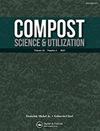1980年和2010年日本家畜废弃物、潜在肥料生产及其利用
IF 0.9
4区 农林科学
Q3 ECOLOGY
引用次数: 2
摘要
摘要这项工作的目的是量化土壤和作物营养元素的生命周期,即氮(N)、磷(P)、钾(K)和碳(C),从牲畜饲料到通过牲畜粪便生产肥料的潜力,这是1980年和2010年日本农田土壤肥料的潜在可持续应用。我们还通过设置几个假设来收集农户的实际比例,从问卷中估计了对农田的实际应用,因为问卷是针对全职农场的,在所有农场中,全职农场的比例都很小。问卷调查共进行了五次,从1979年到2003年,间隔5年,从2008年到2013年进行了一次。这些数据是为1980年和2010年设定的。因此,与1980年相比,2010年牲畜饲料的磷和钾投入降低,牲畜对畜产品的营养利用效率提高,废物产生减少。2010年粪肥生产潜力比1980年有所下降;然而,估计施用的粪肥也从粪肥生产潜力的全部减少到一半。1980年的粪肥施用水平高于农田的可持续施用量。这可能有助于提高土壤肥力;因为当时也需要这样的活动。另一方面,2010年,粪肥的施用量估计不到1980年的一半,尚未达到可持续的施用水平。从1980年到2010年,尽管每种作物的单位面积肥料施用趋势不同,但肥料施用量一直在减少。尽管肥料的缺乏或过剩可能并不总是解释土壤肥力的趋势,但我们需要继续调查土壤肥力,以检查和监测土壤肥力的变化趋势,包括总碳和氮、有效氮、磷和钾,以及估计肥料在农田中的施用量。本文章由计算机程序翻译,如有差异,请以英文原文为准。
Livestock Waste, Potential Manure Production and Its Use in Japan in 1980 and 2010
ABSTRACT The aim of this work is to quantify life cycle of nutrient elements for soil and crops, namely nitrogen (N), phosphorus (P), potassium (K), and carbon (C), from feed of livestock to potential of manure production via livestock waste, a potentially sustainable application of manure for farmland soils in Japan in 1980 and 2010. We also estimated real application to farmland from a questionnaire by setting several hypotheses to collect real proportion of farm households, because the questionnaire was intended for full-time farms, the proportion of which is minor within all farms. The questionnaire survey was conducted five times, from 1979 to 2003 for 5-year intervals, and one time from 2008 to 2013. These data were set for the years 1980 and 2010. As a result, the livestock feed became lower in P and K input, livestock got better nutrient use efficiency for livestock products, and waste production was reduced in 2010 than 1980. Potential of manure production was decreased in 2010 from what it was in 1980; however, estimated application of manure was also reduced from full to half of potential of manure production. Application level of manure in 1980 was higher than the amount that farmland received sustainably. This might be allowed for enhancing soil fertility; as such activity was also needed at that time. On the other hand, in 2010, application of manure was estimated to be less than half of that in 1980 and had not reached sustainable application level. From 1980 to 2010, manure application had been decreased, even though trends of manure application for crops per area were different in each crop. Although lack or surplus of manure might not always explain trend of soil fertility, we need continues survey of soil fertilities to check and monitor to grasp the trend of soil fertility indicated by total C and N, available N, P, and K, as well as estimate application of manure to farmland.
求助全文
通过发布文献求助,成功后即可免费获取论文全文。
去求助
来源期刊

Compost Science & Utilization
农林科学-生态学
CiteScore
4.10
自引率
0.00%
发文量
0
审稿时长
>36 weeks
期刊介绍:
4 issues per year
Compost Science & Utilization is currently abstracted/indexed in: CABI Agriculture & Environment Abstracts, CSA Biotechnology and Environmental Engineering Abstracts, EBSCOhost Abstracts, Elsevier Compendex and GEOBASE Abstracts, PubMed, ProQuest Science Abstracts, and Thomson Reuters Biological Abstracts and Science Citation Index
 求助内容:
求助内容: 应助结果提醒方式:
应助结果提醒方式:


